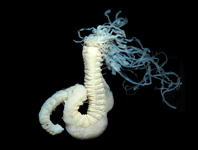Abstract
The genus Thelepus Leuckart, 1849 is well known in Brazilian waters, from a species recorded by several authors as T. setosus (Quatrefages, 1866), which is considered to be a cosmopolitan species. However, the type locality of T. setosus is in France, which renders the presence of this species in Brazilian waters rather unlikely. The wide range of distribution of T. setosus is most likely due to misidentifications, especially because the original description of the species is very brief and does not include several characters now relevant at species level. We provide herein a redescription of the holotype of T. setosus and describe two new species from Brazilian material previously identified as belonging to that species. Thelepus megalabiatum n. sp. is characterised by having an expanded lower lip extending ventrally, many branchial filaments, originating from swollen cushions, with wide mid-dorsal gap between filaments within pairs, 26–33 segments with glandular areas, and 44–61+ pairs of notopodia. Thelepus brevitori n. sp. is characterised by having fewer branchial filaments, originating directly from the body wall, about 17 segments highly glandular ventrally, and up to 27 pairs of notopodia. Both new species are compared to the most similar congeners, including T. setosus.
References
Alves, T.M. (2008) Contribuição ao conhecimento taxonômico de Terebellidae e Trichobranchidae (Annelida: Polychaeta) da Região Sudeste-Sul do Brasil. M. Sc. Dissertation, Instituto de Biociências, Universidade de São Paulo, São Paulo, 176 pp.
Amaral, A.C.Z., Nallin, S.A.H. & Steiner, T.M. (2013) Catálogo das espécies de Annelida Polychaeta do Brasil. Available from: http://www.ib.unicamp.br/museu_zoologia/files/lab_museu_zoologia/Catálogo_Polychaeta_Brasil_Amaral _et_al_
2013_1a.pdf (accessed 15 Sep 2016)Augener, H. (1918) Polychaeta. Beitrage zur Kenntnis der Meeresfauna Westafrikas, 2 (2), 67–625.
Blankensteyn, A. (1988) Terebellidae e Trichobranchidae (Annelida: Polychaeta) da Costa Sudeste do Brasil (24º–27ºS). M.Sc. Dissertation, Instituto de Ciências Biológicas, Universidade Federal do Paraná, Curitiba, 178 pp.
Capa, M. & Hutchings, P. (2006) Terebellidae (Polychaeta) from Coiba National Park, Panamanian Pacific, including description of four new species and synonymy of the genus Paraeupolymnia with Lanicola. Zootaxa, 1375, 1–29.
Carrerette, O. (2015) Diversidade de poliquetas sedentários das Famílias Terebellidae, Thelepodidae, Polycirridae, Trichobranchidae e Sabellidae (Annelida) no Litoral Brasileiro, entre os Estados de São Paulo e Paraíba. Ph. D. Thesis, Instituto de Biociências, Universidade de São Paulo, São Paulo, 368 pp.
Fabricius, O. (1780) Fauna Groenlandica, systematice sistens, Animalia Groenlandiae occidentalis hactenus indagata, quoad nomen specificum, triviale, vernaculumque synonyma auctorum plurium, descriptionem, locum, victum, generationem, mores, usum, capturamque singuli prout detegendi occasio fuit, maximaque parte secundum proprias observations. Impensis Ioannis Gottlob Rothe, Hafniae [Copenhagen] et Lipsiae, 449 pp.
Fauchald, K. (1977) Polychaetes from intertidal areas in Panama, with a review of previous shallow-water records. Smithsonian Contributions to Zoology, 221, 1–81.
https://doi.org/10.5479/si.00810282.221Hessle, C. (1917) Zur Kenntnis der terebellomorphen Polychaeten. Zoologiska bidrag från Uppsala, 5, 39–258, pls. I–V.
Hilbig, B. (2000) Family Terebellidae Grube, 1851. In: Blake, J.A., Hilbig, B. & Scott, P.V. (Eds.), Taxonomic Atlas of the Benthic Fauna of the Santa Maria Basin and Western Santa Barbara Channel. 7 - The Annelida Part 4. Polychaeta: Flabelligeridae to Sternaspidae. Santa Barbara Museum of Natural History, Santa Barbara, pp. 231–294.
Hsueh, P.-W. & Li, K.-R. (2016) New species of Thelepodidae (Terebelliformia, Polychaeta) from Taiwan. Zootaxa, 4170 (3), 510–524.
https://doi.org/10.11646/zootaxa.4170.3.5Hutchings, P.A. (1997) The Terebellidae (F. Polychaeta) from the Wallabi Group, Houtman Abrolhos Islands, Western Australia. In: Wells, F.E. (Ed.), Proceedings of the 7th International Marine Biological Workshop. The marine flora and fauna of the Houtman Abrolhos Islands, Western Australia. Western Australian Museum, Perth, pp. 459–501.
Hutchings, P.A. & Glasby, C.J. (1987) The Thelepinae (Terebellidae) from Australia, with a discussion of the generic and specific characters of the subfamily. Bulletin of the Biological Society of Washington, 7, 217–250.
Hutchings, P.A. & Murray, A. (1984) Taxonomy of polychaetes from the Hawkesbury River and the southern estuaries of New South Wales, Australia. Records of the Australian Museum, 36 (3), 1–118.
https://doi.org/10.3853/j.0812-7387.3.1984.101Hutchings, P.A., Nogueira, J.M.M. & Carrerette, O. (2015) Telothelepodidae, Thelepodidae and Trichobranchidae (Annelida, Terebelliformia) from Lizard Island, Great Barrier Reef, Australia. Zootaxa, 4019 (1), 240–274.
Hutchings, P.A., Nogueira, J.M.M. & Carrerette, O. (2017) Terebelliformia. In: Purschke, G. & Westheide, W. (Eds.), The Handbook of Zoology Online. De Gruyter. [in press]
Leuckart, R. (1849) Zur Kenntnis der Fauna von Island. Archiv für Naturgeschichte, Berlin, 15 (1), 149–208.
Londoño-Mesa, M.H. (2009) Terebellidae (Polychaeta: Terebellida) from the Grand Caribbean Region. Zootaxa, 2320, 1–93.
Londoño-Mesa, M.H. & Carrera-Parra, L.F. (2005) Terebellidae (Polychaeta) from the Mexican Caribbean with description of four new species. Zootaxa, 1057, 1–44.
https://doi.org/10.11646/zootaxa.1057.1.1Luederwaldt, H. 1929. Resultado de uma excursão científica à Ilha de São Sebastião, no litoral do Estado de São Paulo, em 1925. Revista do Museu Paulista, 16, 1–79.
McIntosh, W.C. (1885) Report on the Annelida Polychaeta collected by H.M.S. Challenger during the years 1873–1876. Report on the Scientific Results of the Voyage of H.M.S. Challenger during the years 1872–76, Series Zoology, 12, 1–554.
Nogueira, J.M.M., Fitzhugh, K. & Hutchings, P.A. (2013) The continuing challenge of phylogenetic relationships in Terebelliformia (Annelida: Polychaeta). Invertebrate Systematics, 27, 186–238.
https://doi.org/10.1071/IS12062Nogueira, J.M.M., Hutchings, P.A. & Fukuda, M.V. (2010) Morphology of terebelliform polychaetes (Annelida: Polychaeta: Terebelliformia), with a focus on Terebellidae. Zootaxa, 2460, 1–185.
Quatrefages, A. de (1866) Note sur la Classification des Annélides. Annales des Sciences Naturelles, 5, 253–296.
Sars, G.O. (1872) Diagnoser af nye Annelider fra Christianiaforden, efter Professor M. Sar's efterladte Manuskripter. Forhandlinger fra Videnskabs-Selskabet i Christiania, 1871, 406–417.
Treadwell, A.L. (1901) The polychaetous annelids of Porto Rico. Bulletin of the United States Fish Commission, 20 (2), 181–210.
Treadwell, A.L. (1911) Polychaetous annelids from the Dry Tortugas, Florida. Bulletin of the American Museum of Natural History, 30, 1–12.
Treadwell, A.L. (1931) New terebellid annelids, Thelepus haitiensis and Terebella hiata. Two new species from Haiti. Zoologica, 12 (8), 79–81.

